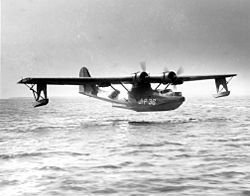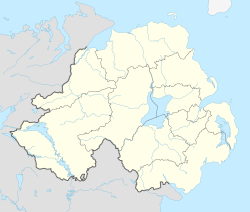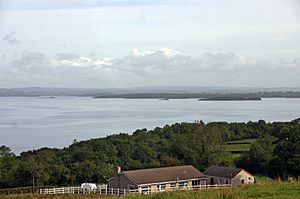RAF St Angelo facts for kids
Quick facts for kids RAF St AngeloNo. 18 SLG |
|||||||||
|---|---|---|---|---|---|---|---|---|---|
| Trory, County Fermanagh in Northern Ireland | |||||||||

Catalina flying boat of the type based at St Angelo during the Second World War
|
|||||||||
|
Shown within Northern Ireland
|
|||||||||
| Coordinates | 54°23′55″N 007°39′07″W / 54.39861°N 7.65194°W | ||||||||
| Type | Royal Air Force Station | ||||||||
| Site information | |||||||||
| Owner | Air Ministry | ||||||||
| Operator | Royal Air Force | ||||||||
| Controlled by | RAF Coastal Command | ||||||||
| Site history | |||||||||
| Built | 1940 | ||||||||
| In use | 1941-1947 | ||||||||
| Battles/wars | European theatre of World War II | ||||||||
| Airfield information | |||||||||
| Elevation | 47 metres (154 ft) AMSL | ||||||||
|
|||||||||
RAF St Angelo was a special air base used by the Royal Air Force (RAF) during World War II. It was located near Trory in County Fermanagh, Northern Ireland. The base was also used by the Royal Navy's Fleet Air Arm, which is their air force. The name St Angelo likely came from a nearby house that was used by the base commander.
After the war, from the 1970s, the airfield became known as St Angelo Barracks. It was used by the British Army and the Ulster Defence Regiment for housing soldiers and for helicopter flights during a period of conflict in Northern Ireland called The Troubles.
Today, St Angelo is a private airport. It has one runway and is used for private flights, but no regular passenger planes fly from there.
Contents
A Look Back: History of RAF St Angelo
World War II: A Busy Airfield
RAF St Angelo started in April 1941 as a smaller, supporting airfield for RAF Aldergrove. On September 15, 1941, it became a main fighter base. It was home to two squadrons of fighter planes:
- No. 133 Squadron RAF flew Supermarine Spitfires.
- No. 134 Squadron RAF flew Hawker Hurricanes.
These planes helped stop enemy spy aircraft off the coast of Ireland and protected Belfast from air attacks.
It's thought that RAF St Angelo was the first RAF base to have its defensive pillboxes (small concrete forts) built with gun openings facing inwards. This was done to protect against the chance of German paratroopers landing on the runways.
St Angelo was also the main base for No. 131 Operational Training Unit, which was located at RAF Killadeas. St Angelo was unique among the three RAF bases on Lough Erne because it had land-based runways, unlike the others that mainly used the lake for flying boats.
In August 1943, St Angelo became a supporting airfield for RAF Coastal Command. This group was in charge of all the flying boat squadrons on Lough Erne. St Angelo became home to several squadrons of Consolidated PBY Catalina and Short Sunderland flying boats. These large planes could land and take off from the water of Lough Erne. Later that year, Bristol Beaufighter planes from No. 235 Squadron RAF were based at St Angelo. They flew patrols to hunt for enemy submarines in the Irish Sea and the Atlantic Ocean.
One successful mission from the base happened on March 10, 1944. A Short Sunderland flying boat from St Angelo, flown by Warrant Officer W.F. Morton and his crew, sank an enemy submarine, U-625. This was a big achievement for the crew.
A small group of US Navy pilots arrived in July 1943. They stayed at St Angelo until the end of the war, helping to train RAF pilots on how to fly the American-built Catalina planes. The base also housed Royal Navy airmen who were part of HMS Pintail until April 1946.
As the war slowed down in Northern Ireland in 1944, a special school for flying instructors was set up at both Killadeas and St Angelo. This school later moved to Scotland in February 1945.
After the War: Military Use Continues
Between August 1945 and February 1947, RAF St Angelo was used as a storage and dismantling site. Old Avro Anson planes were stored there before being sold or gotten rid of.
Later, St Angelo became a key base for helicopter operations in Northern Ireland. The base was given to the British Army and used as barracks for soldiers from the British Army and the Ulster Defence Regiment during The Troubles. Most of the soldiers lived in temporary buildings. The base was attacked several times by mortar fire in the early 1980s and early 1990s. On February 15, 1991, there was an attempt to shoot down a helicopter from St Angelo that was picking up soldiers after a border patrol.
The military stopped using St Angelo in March 1996. The temporary buildings were then taken down.
What is St Angelo Used for Today?
Today, St Angelo is a privately owned airport. It doesn't have any regular commercial flights. In 2004, there was a plan to make the airfield an historic monument because it was one of the best-preserved World War II RAF bases in Northern Ireland. However, the landowners quickly demolished most of the old wartime buildings and defenses before this could happen.
The airport now hosts private aviation businesses, including those that deal with planes that can land on both land and water. The facility is still being developed and improved.
Other Places with the Same Name
It's important not to confuse RAF St Angelo with HMS St Angelo. HMS St Angelo was a Royal Navy air base in Malta during World War II. The Royal Navy took over and renamed RAF Ta' Qali as HMS St Angelo when it started operating flying boats after the Siege of Malta.
See also
- List of former Royal Air Force stations




